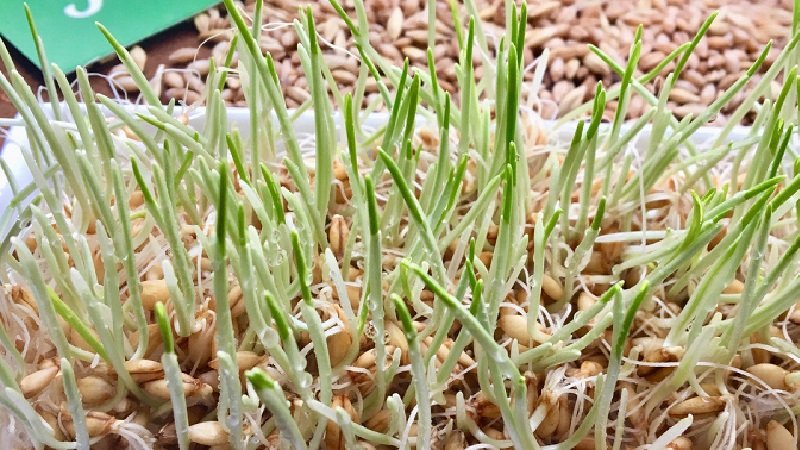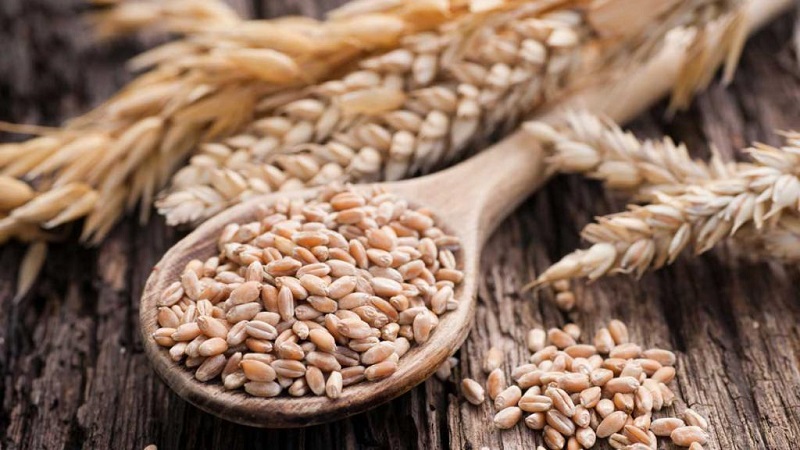How to germinate barley at home and what is it for
Sprouted barley is a biologically active food supplement that improves overall human health. The product increases the body's defenses, cleanses and replenishes the deficiency of vitamins and minerals, activates the endocrine system.
How to germinate barley at home, and how much you can eat without harm to health, we will tell in our article.
The content of the article
Sprouted barley properties
At the initial stage of germination of barley, biochemical processes are accelerated, due to which the grains have a beneficial effect on the body:
- kill bacteria;
- relieve inflammation;
- tone up;
- envelop the walls of the stomach, preventing trauma and irritation of the mucous membrane;
- stimulate immunity;
- cleanse of toxins and toxins;
- lower body temperature.
Chemical composition and nutritional value
Sprouted barley is rich in vitamins:
- B1 (thiamine);
- B2 (riboflavin)
- B4 (choline);
- B5 (pantothenic acid);
- B6 (pyridoxine);
- H (biotin);
- PP (niacin);
- E (alpha tocopherol).
Grain contains minerals:
- potassium;
- calcium;
- silicon;
- magnesium;
- sodium;
- sulfur;
- phosphorus;
- chlorine;
- boron;
- vanadium;
- iron;
- iodine;
- cobalt;
- manganese;
- copper;
- molybdenum;
- nickel;
- selenium;
- fluorine;
- chromium;
- zinc.

Nutritional value of the product per 100 g:
- calorie content - 288 kcal;
- proteins - 10.3 g;
- fats - 2.4 g;
- carbohydrates - 56.4 g;
- water - 14 g;
- fiber - 14.5 g;
- ash - 2.4 g;
- sucrose - 0.51 g;
- glucose - 0.2 g
Sprouted barley contains a large amount of:
- enzymes and pectins that improve digestion;
- essential amino acids;
- antioxidants.
Benefit and harm
Nutritionists recommend eating sprouted barley grains for:
- general strengthening of the body;
- increasing metabolism;
- regulation of the heart and thyroid gland;
- increasing the level of iron in the blood;
- normalization of the central nervous system;
- normalization of blood pressure;
- lowering cholesterol and sugar;
- decrease excess weight;
- strengthening hair follicles;
- cleansing the liver;
- restoration of musculoskeletal and cartilage tissue;
- elimination of free radicals;
- collagen synthesis;
- skin rejuvenation;
- increasing immunity;
- enhancement of sexual function.
Official medicine does not prohibit and even insists on the inclusion of sprouted grains in the diet for conditions and diseases such as:
- sugar diabetes;
- angina;
- dermatitis;
- polyarthritis;
- bronchitis;
- furunculosis;
- insomnia;
- violation of intestinal microflora;
- deficiency of vitamins and minerals;
- tuberculosis;
- asthma;
- infertility;
- sinusitis;
- thrombophlebitis;
- osteoporosis;
- hemorrhoids;
- prostatitis;
- pharyngitis;
- obesity;
- disorders of the cardiovascular, digestive and genitourinary systems.
The dietary supplement is well tolerated by the body and practically does not cause side effects. In rare cases, manifestations of an individual allergic reaction are possible.
Attention!Doctors advise people over 65 years of age to use sprouted barley with caution due to the high fiber content, which causes intestinal colic and flatulence.

How to germinate barley correctly
Barley is sold in specialty health food stores, but grains can be germinated at home in ordinary glassware between layers of gauze without any problems. The process is facilitated by automatic grain sprouters. Water is poured into the unit, prepared grains are poured and the optimal mode is selected. The system independently irrigates the barley by regulating the moisture level. This technique is suitable for those who are involved in the germination of grain in large quantities.
We will tell you about the simplest way to obtain biologically active sprouts using materials at hand.
Choice of grains
Suitable for germination is unrefined grain (in a shell) of high quality, without signs of mold, collected no earlier than two months ago. This product contains all the nutrients.
Optimal conditions
Grains begin to germinate at an air temperature of at least + 20 ° C and a sufficient level of moisture. Do not let the material dry, spray it with water every day. Subject to the rules of germination, sprouts will begin to appear in 2-3 days.
Germination instructions
The process of obtaining biologically active barley has the following sequence of actions:
- Rinse the grains in boiled water cooled to room temperature and soak for 48-72 hours.
- Change the water every seven hours.
- Place the barley between the layers of cheesecloth and place in a glass bowl. Cover and place in a dark place. Do not spread the layer more than 2-3 cm, otherwise the material will sour.
- Sprinkle the top layer with water periodically and air the grains once a day for 15 minutes. To do this, remove the lid and fold the gauze.
- After the grain sprouts and the length of the shoots is 1-3 mm, put the material in a colander and rinse with boiled water.
Reference. The most useful are seedlings 2-3 mm long. They contain the maximum amount of vitamins and minerals.
There is another way to germinate barley - for malt. This is a time consuming process. The material is chosen taking into account the percentage of germination, which should reach 90%.
The sequence of actions is the same, with the difference that the length of the seedlings should be one and a half times the size of the grain. It is also necessary to increase the moisture level after the first seedlings hatch. This will help more frequent spraying of the grains. The optimum air temperature is + 15 ° C. The whole process takes about a week. The barley is then dried and kept in linen bags for a month before making drinks from it.

Terms and conditions of storage
Sprouted barley for human consumption is stored for no longer than 24 hours in refrigerator.
Barley for malt is stored in the refrigerator for 48-72 hours. To increase the shelf life, the product is dried at a temperature of 50-55 ° C.
How to use
Sprouted barley is best digested in the morning. The kernels can be eaten whole by chewing thoroughly. They serve as an excellent addition to salads, sandwiches. Grains rolled in a meat grinder are mixed with honey, nuts, raisins, dried apricots, prunes, dates, figs, herbs, lemon. It turns out a very tasty pasta.
Healthy milk is prepared from sprouted grains. To do this, grind the barley into a homogeneous mass using a blender and pour two glasses of water. The mass is thrown onto a sieve, wiped, then filtered through cheesecloth and diluted with water to the desired consistency. On its basis, delicious cocktails with banana, apple, berries, dried fruits are obtained.
Barley jelly is useful for gastrointestinal diseases and diabetes mellitus. Sprouted and dried grains are scrolled through a meat grinder, a little cold water is added, then boiling water, infused for 10-12 minutes and filtered.
Decoctions increase the production of breast milk, regulate sugar levels, treat colds and coughs, liver and kidney diseases. This drink is even given to babies as a nutritional supplement.
Sprouts consumption rates
Nutritionists recommend gradually introducing sprouted grains into the diet, starting with 1-2 teaspoons. As the body gets used to it, the rate is increased to 60-70 g per day.
Where else is sprouted barley used?
Sprouted barley grains are used for baking bread. To do this, grind them into a homogeneous mass and knead the dough.The bread is very nutritious, retains minerals, vitamins, fiber, amino acids, proteins. Such a product is much more beneficial than white bread made from refined flour.
Malt is prepared from barley - a sprouted grain in which starch is converted into sugar, which is necessary to obtain alcohol. On its basis, beer, moonshine, whiskey are made.
Contraindications
Healthy people have nothing to fear about the possible negative impact of sprouted barley on the body. The product is often well tolerated, with the exception of individual intolerance to the components.

It is completely contraindicated to consume grain when:
- chronic discomfort in the digestive tract (constipation, loose stools);
- ulcers of the stomach and intestines;
- flatulence;
- colic;
- gallstone disease in the acute stage;
- pancreatitis.
Council. Drinking a regimen can help reduce the harmful effects of fiber on a weakened intestine. Drink at least 1.5-2 liters of clean water per day to improve food promotion.
Read also:
Conclusion
Sprouting barley at home allows you to get a useful biologically active product that serves as a source of essential vitamins, minerals, amino acids, fiber and proteins. Regular consumption of grains provides energy for people leading an active lifestyle.